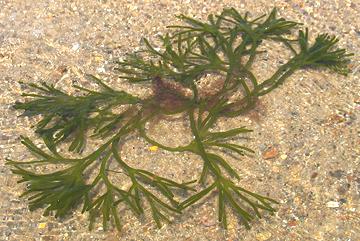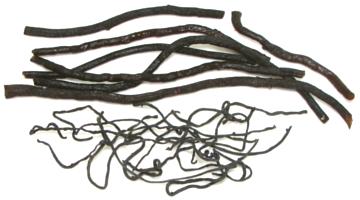Sponge Seaweed
 [Green sea fingers, Dead man's fingers. Oyster thief; Ch'onggak,
Nokkakch'ae (Korea); Codium fragile]
[Green sea fingers, Dead man's fingers. Oyster thief; Ch'onggak,
Nokkakch'ae (Korea); Codium fragile]
This coastal seaweed is a siphonous alga, meaning its round branches
are composed of a tangle of near microscopic filaments, each filament
being a single multinucleate cell. This accounts for its spongy texture.
Its branching fronds grow up to about 12 inches long.
Sponge seaweed is very common as a temperate Pacific species from
around Japan, but is also found along the Pacific coasts of Canada,
California and northern Mexico. Two subspecies were thought to be
invasives around Ireland and Britain, but genetics have shown them to
be a separate population. It is possibly an invasive in other parts of
the North Atlantic, especially along the Atlantic coast of North America
and is a serious problem in Massachusetts. One subspecies grows around
Australia, New Zealand, South America, the Falkland Islands, the southern
tip of Africa and possibly as far south as Antarctica. Subspecies also
exist in small regions of the Mediterranean.
This seaweed can be a problem in shellfish beds, because it can grow
profusely on the shells, hindering movement and feeding, and sometimes
breaks them lose and floats them away, thus the name "Oyster Thief".
Photo by Flyingdream contributed to the Public Domain
.
More on Algae and Cyanobacteria.
Sponge Seaweed is used in various skin rejuvenation products, but
in Asia, particularly Korea, it is used for food, particularly as
a flavor and aroma modifying ingredient. It has a distinctive aroma
compared to other seaweeds.
 This seaweed is valued in Korea mainly for inclusion in a number
of kimchees, especially watery kimchees or those with a fish component.
It is reputed to eliminate fishy smells, the smell of garlic, and
aftertastes. The strands are typically 0.040 inch diameter dried and
0.120 after soaking.
This seaweed is valued in Korea mainly for inclusion in a number
of kimchees, especially watery kimchees or those with a fish component.
It is reputed to eliminate fishy smells, the smell of garlic, and
aftertastes. The strands are typically 0.040 inch diameter dried and
0.120 after soaking.
Buying & Storing:
This seaweed is
not easy to find, even in Korean markets here in Los Angeles. You have
to take great care, because other seaweeds are often very thinly sliced
into threads that look a lot like this one, and the package for all of
them will probably just say "Dried Seaweed". The strands of this seaweed
are round, not square, and it tends to be very tangled.
Cooking:
This seaweed is always soaked before cooking.
It can be simmered a bit and served with a dash of rice vinegar to
enliven it, but it's main use as an ingredient in kimchees.
al_spongz 150926 - www.clovegarden.com
©Andrew Grygus - agryg@clovegarden.com - Photos
on this page not otherwise credited © cg1
- Linking to and non-commercial use of this page permitted
 This seaweed is valued in Korea mainly for inclusion in a number
of kimchees, especially watery kimchees or those with a fish component.
It is reputed to eliminate fishy smells, the smell of garlic, and
aftertastes. The strands are typically 0.040 inch diameter dried and
0.120 after soaking.
This seaweed is valued in Korea mainly for inclusion in a number
of kimchees, especially watery kimchees or those with a fish component.
It is reputed to eliminate fishy smells, the smell of garlic, and
aftertastes. The strands are typically 0.040 inch diameter dried and
0.120 after soaking. [Green sea fingers, Dead man's fingers. Oyster thief; Ch'onggak,
Nokkakch'ae (Korea); Codium fragile]
[Green sea fingers, Dead man's fingers. Oyster thief; Ch'onggak,
Nokkakch'ae (Korea); Codium fragile]